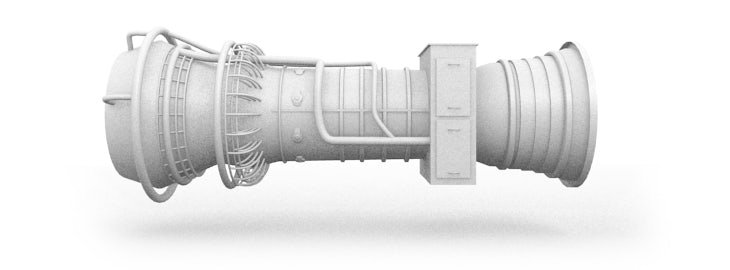It is important to detect vibrations at an early stage to prevent damage. The consequences of vibrations should not be underestimated. For instance, vibrations in a turbine can have catastrophic effects on people, the environment, and the factory. Detecting vibrations and their causes early helps prevent unnecessary accidents and high costs. Often, only minor maintenance interventions or repairs are needed.
Causes of machine vibrations
There are many causes for machine vibrations. The most common are explained below.
Repetitive forces
Repetitive forces arise from a force pattern that repeats itself. Often, these forces in machines are caused by:
- The machine is unbalanced:
The center of gravity of a rotating machine part is not in the center. This causes a repetitive force on the machine. - The machine is misaligned:
Machine parts bend during rotation, causing repetitive forces on the machine. - Wear and tear on the machine:
Machine parts wear out through use. Consider, for example, bearings and gears. This can cause repetitive forces. - Improper operation of the machine:
An irregular power supply can cause repetitive forces to arise.
Resonance
Every machine has a certain natural vibration. Every machine has a resonant frequency (or several). When this resonant frequency coincides with the rotational speed, resonance occurs. If it involves a relatively small force, this will not cause many problems. However, large forces can have catastrophic consequences.
Loose parts
Causes such as bearings with too much play, loose bolts, and corrosion can cause the machine to vibrate. Due to the enormous forces in the machine, loose parts can quickly lead to damage.
Types of vibrations
Three types of vibration forms are distinguished:
- Aperiodic vibrations
These vibrations do not repeat over time, making the behavior unpredictable. - Transitional vibrations
These vibrations can only be observed for a certain period. - Periodic vibrations
These are vibrations that repeat. These are the most common vibrations in machines (see figure 1).
What can vibration measurements prevent?
Performing vibration measurements naturally costs money. Therefore, it is important to understand what can be prevented with it, or rather; which costs can be saved.
Severe machine damage
If vibrations are not detected early, severe damage to the machine often occurs. In the most extreme cases, the entire machine must be replaced. Early detection of the cause of vibrations can save a lot of costs and also benefits safety.
High energy consumption
Vibrating machines consume more energy. Extra energy is needed to resist the vibrations. By measuring the condition of the machine, this can be minimized.
Unplanned downtime
If the condition of a machine is not measured, a machine can suddenly break down. Unplanned downtime is the result. Since many factories in the process industry need to be constantly operational, this results in extremely high (unnecessary) costs. In many cases, this can be prevented with simple interventions, but then the condition of the machine must be monitored.
Delivery problems
Many companies must adhere to certain delivery agreements. If a machine unexpectedly stops due to defective parts or severe damage, there is a high chance that the company will not be able to meet these agreements. This will lead to customer dissatisfaction.
Semi-finished products
When a machine unexpectedly comes to a standstill, semi-finished products are left in the process. In many cases, these must be discarded due to spoilage. At the very least, this incurs unnecessary costs.
Unnecessary maintenance
Often, parts of machines are preventively replaced to ensure that the machine is available at all times. This can result in parts being unnecessarily replaced. By measuring the condition of the machine (parts), repairs and replacements are only done when truly necessary.
Quality issues
In many cases, it may seem to the naked eye that a machine is functioning well, although this is sometimes not the case. Measurements are needed to determine this. If this is not done, the quality of the products may suffer.
Condition monitoring
Condition monitoring involves checking the condition of machines. There are various methods for this, but vibration measurements are the most reliable method. Read more about condition monitoring »

